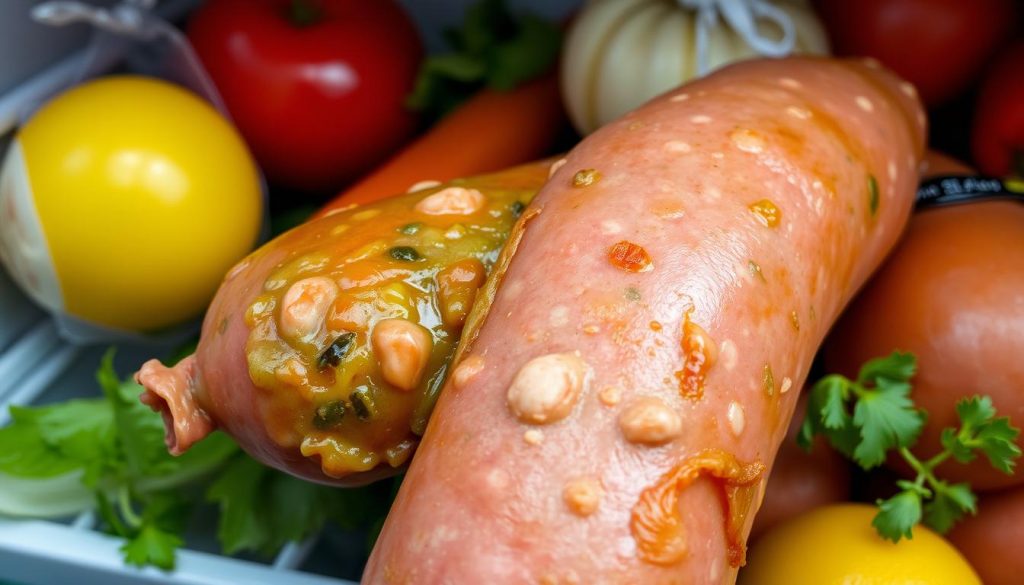Italian sausage adds flavor to many dishes, but knowing its fridge life is crucial. We’ll explore its shelf life and share tips for keeping it fresh. Understanding proper storage helps you enjoy sausage safely, whether it’s fresh or pre-cooked.
Proper refrigeration is key to extending Italian sausage shelf life. We’ll cover how long you can keep this tasty meat in your fridge. Our guidelines will help you maximize the quality and safety of your sausage.
Key Takeaways
- Italian sausage shelf life varies between fresh and pre-cooked types
- Proper refrigerator storage is essential for maintaining sausage freshness
- Temperature control plays a crucial role in preserving Italian sausage
- Signs of spoilage include color changes, off-odors, and slimy texture
- Freezing can extend the shelf life of Italian sausage significantly
- Safe handling practices are vital for preventing foodborne illness
Understanding Italian Sausage: Fresh vs Pre-Cooked Varieties
Italian sausage comes in various forms with unique characteristics. Let’s explore fresh and pre-cooked varieties, their ingredients, and preservation methods. We’ll uncover the key differences between these tasty options.
Fresh Italian Sausage Characteristics
Fresh Italian sausage is raw and needs cooking before eating. It’s made from ground pork with fennel, garlic, and spices. The sausage is soft and pliable, with a pink or light red color.
Pre-Cooked Sausage Types
Pre-cooked sausages are fully prepared during manufacturing. You can eat them cold or heated. These sausages often have a firmer texture and darker color than fresh ones.
Ingredient Composition and Preservation
Sausage ingredients affect taste and shelf life. Fresh sausages have few preservatives. Pre-cooked types may have more to last longer.
| Type | Main Ingredients | Preservatives | Shelf Life (Refrigerated) |
|---|---|---|---|
| Fresh Italian Sausage | Pork, fennel, garlic, spices | Minimal | 1-2 days |
| Pre-cooked Sausage | Cooked pork, spices | Salt, nitrites | 7-14 days |
Knowing these differences helps with proper storage and cooking. This ensures you get the best flavor and safety from your Italian sausages. Enjoy your delicious sausage adventure!
How Long Does Italian Sausage Last in the Fridge
Italian sausage storage time depends on several factors. We’ll explore fridge storage duration for different types of Italian sausages. This guide will help you keep your meat fresh and safe.
Fresh Italian sausage has a shorter shelf life than pre-cooked varieties. When stored properly, fresh sausages last 1-2 days in the fridge. Pre-cooked sausages can stay fresh for up to two weeks when refrigerated.
You can extend the sausage refrigeration time by following proper storage techniques. Unopened packages of fresh sausage last 3-4 days in the fridge. Opened packages should be used within 1-2 days for best quality.
| Sausage Type | Refrigerator (40°F or below) | Freezer (0°F or below) |
|---|---|---|
| Fresh Italian Sausage (unopened) | 3-4 days | 1-2 months |
| Fresh Italian Sausage (opened) | 1-2 days | 1-2 months |
| Pre-cooked Italian Sausage | 1-2 weeks | 1-2 months |
These timeframes are general guidelines. Always check for signs of spoilage before eating sausages. If you’re unsure about freshness, it’s best to throw the sausage away.
“When in doubt, throw it out” is a good rule of thumb when dealing with perishable foods like Italian sausage.
Understanding these storage guidelines helps you enjoy Italian sausages safely. Follow these tips to make the most of your delicious meats.
Proper Storage Techniques for Maximum Freshness
Keeping Italian sausage fresh is vital for enjoying its flavors. Let’s explore some storage tips to maintain quality and extend shelf life.
Optimal Temperature Settings
Set your refrigerator between 34°F and 38°F for ideal sausage storage. This range slows bacterial growth without freezing the meat. Check your fridge’s temperature often to ensure consistent cooling.
Best Container Options
Use airtight containers or resealable plastic bags for storing Italian sausage. These options prevent air exposure and cross-contamination. Glass containers work well too, offering a clear view of the contents.
Packaging Methods
Wrap sausages individually in plastic wrap or butcher paper before placing them in containers. This extra layer protects against freezer burn and helps with portion control.
For longer storage, consider vacuum sealing. It can significantly extend the sausage’s shelf life.
| Storage Method | Shelf Life | Best For |
|---|---|---|
| Original packaging | 1-2 days | Quick use |
| Airtight container | 3-4 days | Short-term storage |
| Vacuum sealed | 7-10 days | Extended freshness |
Proper fridge organization is crucial for maintaining sausage quality. Store raw meats on the bottom shelf to prevent drips onto other foods.
Keep sausages away from produce to avoid cross-contamination. This simple step helps ensure food safety.
Signs of Spoilage in Italian Sausage
Spotting spoiled sausage is vital for food safety. Our guide helps you check sausage quality at home. You can easily detect spoilage using your senses.

Look for color changes first. Fresh Italian sausage should be pinkish-red. Gray or brown patches mean it’s time to discard it.
Check the texture next. Slimy or sticky sausages are unsafe to eat. They’ve gone past their prime.
Your nose can detect spoilage too. Fresh sausage has a mild, meaty smell. A sour or rotten odor means it’s gone bad.
| Sense | Fresh Sausage | Spoiled Sausage |
|---|---|---|
| Sight | Pinkish-red color | Gray or brown patches |
| Touch | Firm texture | Slimy or sticky surface |
| Smell | Mild, meaty aroma | Sour or rotten odor |
If you’re unsure, it’s best to throw it out. Wasting food is better than risking illness. Stay alert and check your sausages regularly.
Freezing Italian Sausage: Step-by-Step Guide
Freezing sausage extends its shelf life and maintains quality. This guide will help you freeze Italian sausage properly. You’ll learn how to preserve its flavors and textures effectively.
Preparation for Freezing
Wrap each sausage link individually in plastic wrap or aluminum foil. This prevents freezer burn and keeps sausages from sticking together.
Place wrapped sausages in a freezer-safe plastic bag for extra protection. Remove as much air as possible from the bag before sealing.
Recommended Freezing Methods
Flash freezing works best for sausage preservation. Arrange wrapped sausages on a baking sheet and freeze for 2-3 hours.
After freezing, transfer sausages to a freezer bag. This method prevents clumping and allows easy portion control.
Thawing Techniques
Proper thawing is crucial for frozen sausages. The safest way is to thaw in the refrigerator overnight.
For quicker results, use the cold water method. Submerge the sealed package in cold water, changing it every 30 minutes.
| Thawing Method | Time Required | Best For |
|---|---|---|
| Refrigerator | 8-12 hours | Planned meals |
| Cold Water | 1-2 hours | Same-day cooking |
| Microwave | 5-10 minutes | Immediate use |
Follow these freezing and thawing steps for best results. Your Italian sausages will stay fresh and flavorful for months.
Safe Handling and Food Safety Guidelines
Proper sausage handling is vital for safe and tasty meals. Let’s explore key steps to keep your Italian sausage safe and delicious.

Always wash your hands before and after handling raw meat. Use separate tools for raw sausage to avoid cross-contamination. Keep your workspace clean and germ-free.
Cook Italian sausage to 160°F (71°C) to kill harmful bacteria. A meat thermometer is essential for checking doneness.
Store raw sausages on the bottom shelf of your fridge. This prevents drips and lowers contamination risk.
- Wash hands for 20 seconds with soap and warm water
- Use separate utensils for raw and cooked meats
- Clean surfaces with hot, soapy water after food preparation
- Refrigerate or freeze sausages promptly after purchase
| Food Safety Step | Why It’s Important |
|---|---|
| Hand washing | Removes bacteria from hands |
| Separate utensils | Prevents cross-contamination |
| Proper cooking temperature | Kills harmful bacteria |
| Quick refrigeration | Slows bacterial growth |
These guidelines help reduce risks when handling raw meat. Safe food practices are crucial for enjoying your Italian sausage. Treat food safety as a key ingredient in every meal!
Extending Shelf Life: Tips and Tricks
Let’s explore advanced ways to keep Italian sausages fresh longer. These techniques will help extend shelf life and maintain quality.
Vacuum Sealing Benefits
Vacuum sealing is a game-changer for preserving Italian sausages. It removes air, preventing oxidation and bacterial growth. This method can double or triple sausage shelf life in the fridge.
Temperature Control Strategies
Proper temperature control is crucial for sausage longevity. Keep your fridge at 40°F (4°C) or below. Use a thermometer to check the temperature regularly.
Place sausages in the coldest part of the fridge. This is usually the back of the bottom shelf.
Moisture Management
Excess moisture can lead to spoilage. Wrap sausages in paper towels before storing in airtight containers. This absorbs moisture while allowing some airflow.
| Preservation Technique | Shelf Life Extension | Best For |
|---|---|---|
| Vacuum Sealing | 2-3 times longer | Both fresh and cooked sausages |
| Temperature Control | 1-2 days extra | All types of sausages |
| Moisture Management | 1-2 days extra | Fresh sausages |
Combining these techniques can greatly extend your Italian sausages’ shelf life. Vacuum sealing and temperature control are key to maintaining freshness. Try these methods to enjoy your sausages for longer.
Cooking Methods That Help Preservation
Cooking sausage isn’t just about making a tasty meal. It’s also a way to extend its life. Some great techniques can keep your Italian sausages fresh longer.
Par-cooking is a top method for preserving sausages. It involves partially cooking them, killing harmful bacteria and slowing spoilage. After par-cooking, cool the sausages quickly and store them in the fridge.
Smoking is another excellent way to preserve sausages. The smoke adds flavor while extending shelf life. Smoked sausages can last up to two weeks in the fridge.
Curing is a traditional method that’s still effective today. Adding salt and nitrates can significantly extend sausage life. Cured sausages can last for months in cool, dry conditions.
| Cooking Method | Preservation Time | Flavor Impact |
|---|---|---|
| Par-cooking | 1-2 weeks | Minimal |
| Smoking | 2-3 weeks | Strong smoky flavor |
| Curing | Several months | Intensified savory taste |
These methods help preserve sausages and enhance flavors. Try different techniques to find your favorite way of cooking sausage. You’ll enjoy longer-lasting, delicious sausages.
Common Storage Mistakes to Avoid
Storing sausages properly is crucial for food safety. Let’s look at common mistakes and how to fix them.
Temperature Fluctuations
Exposing meat to temperature changes is a major mistake. Keep your fridge at 40°F or below consistently. Don’t leave sausages on the counter for long.
Rapid bacterial growth and spoilage can occur if sausages aren’t stored correctly. Always return them to the fridge promptly after use.
Cross-Contamination Risks
Letting raw sausages touch other foods is a common error. Store raw meats on the bottom shelf in sealed containers. This stops juices from dripping onto other items.
By separating raw meats, you reduce the risk of foodborne illness. It’s a simple step that makes a big difference.
Improper Packaging Issues
Using the right packaging is key for proper meat storage. Don’t keep sausages in their original store packaging. It can lead to faster spoilage.
Transfer sausages to airtight containers or wrap them tightly. Use plastic wrap or aluminum foil. This keeps them fresh and prevents freezer burn.
| Common Mistake | Potential Consequence | Prevention Tip |
|---|---|---|
| Inconsistent fridge temperature | Bacterial growth | Maintain fridge at 40°F or below |
| Storing raw sausage above other foods | Cross-contamination | Use bottom shelf and sealed containers |
| Keeping sausages in original packaging | Quicker spoilage | Transfer to airtight containers or wrap tightly |
Avoiding these mistakes keeps Italian sausages fresh and safe. Proper storage maintains quality and prevents illness. Your sausages will taste better and last longer.
Best Practices for Restaurant-Style Storage
Commercial kitchens have perfected Italian sausage storage techniques. These methods can be easily adapted for home use. You’ll keep your sausages fresh and tasty with these pro tips.
Temperature control is key in professional food storage. Set your fridge to 38°F (3°C) to slow bacterial growth. Use a thermometer to check the temperature regularly.
Clear, labeled containers are a commercial kitchen staple. They help with organization and quick identification. Use airtight containers or vacuum-sealed bags to extend shelf life.
Proper rotation is crucial in restaurant-grade preservation. Use the “first in, first out” (FIFO) method. Place newer sausages behind older ones to reduce waste.
- Store sausages in the coldest part of your fridge, usually the bottom shelf
- Keep raw sausages separate from cooked foods to prevent cross-contamination
- Use a meat thermometer to ensure sausages reach 160°F (71°C) when cooking
These pro tips will help you maximize sausage freshness. You’ll be storing Italian sausages like a chef in no time.
Shopping and Transportation Tips
Smart grocery shopping improves Italian sausage quality. Here are tips to pick the best sausages and transport them safely.
Selection Guidelines
Choose firm sausage links with bright colors. Avoid packages with excess liquid or discoloration. Check sell-by dates for freshness.
Ask the butcher for recommendations on the best choices. They can guide you to the freshest options available.
Transport Temperature Control
Keep sausages cold during your trip home. Use insulated bags or coolers, especially on hot days or long drives.
Place sausages in the coolest part of your car. Avoid direct sunlight to maintain freshness and prevent bacterial growth.
Time Management
Make the meat section your last stop before checkout. This reduces time sausages spend at room temperature.
Refrigerate or freeze your sausages immediately when you get home. These steps ensure your Italian sausages stay fresh and tasty.




